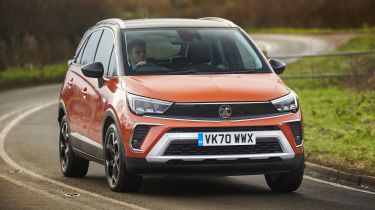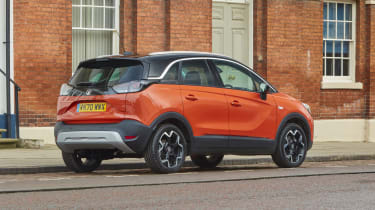Vauxhall Crossland SUV - Engines, drive & performance
Sensible, spacious and comfortable it may be, but the Vauxhall Crossland is no driver’s car
If you enjoy driving, you may wish to consider an alternative to the Vauxhall Crossland – a conventional hatchback such as the Vauxhall Astra, perhaps. Because while the Crossland has an increased ride height – very much en vogue at present – this also causes some problems.
The Crossland is roughly 10cm taller than the Astra, so you and your passengers will find a vast amount of open space above your heads. This leads to a pleasant sense of airiness. But the Crossland's high profile translates into too much wind noise around the windscreen pillars at cruising speeds. Strong winds on exposed motorways lead to more buffeting than you might be used to.
Turn off the motorway onto smaller roads and, while the revised suspension fitted to the facelifted Crossland does a reasonable job of absorbing vibrations caused by poor tarmac, the Crossland's raised height means its body undoes the good work of the suspension, as the raised centre of gravity leads to the body swaying when travelling at speed over uneven surfaces. It's more stable than before, but the Ford Puma is far more like a sporty hatchback to drive.
The steering is very responsive and quick – a relatively small adjustment from your hand translates to fairly large movements from the car. However, you may find yourself wishing for a better resolved and more relaxed driving experience.
More reviews
In-depth reviews
When it comes to combining comfort and agility, the Peugeot 2008 is a more balanced package. By comparison, the Renault Captur and Nissan Juke are by no means enthusiasts' cars; but the Crossland's comfortable seats, excellent driving position and sound ergonomics feel a little undermined by the car's indecision on whether to be relaxing or sporty.
Vauxhall Crossland petrol engines
There's better news where the Crossland’s engine range is concerned: the three-cylinder, 1.2-litre turbocharged petrol engine is easy to recommend thanks to its perky nature and broad spread of power throughout the rev range. This engine is available in two turbocharged guises: 108 and 128bhp, with both now featuring a six-speed manual gearbox. Zero-to-62mph takes 10.2 and 9.3 seconds respectively, so both offer a decent turn of speed.
The 128bhp petrol feels like it has plenty of power, particularly in the lower gears, but the gear changes feel somewhat imprecise and take a long throw. You'll rarely need more than fifth gear in everyday driving, with sixth keeping the revs low on the motorway for better fuel economy.
There's also an entry-level 80bhp non-turbocharged 1.2-litre petrol engine. While we haven't driven a Crossland in this configuration yet, we can't imagine it'll be much fun to live with. Acceleration takes a much more leisurely 13.6 seconds, so we'd recommend opting for a turbocharged petrol engine unless low insurance premiums are a priority.
Diesel engines
If you drive lots of motorway miles and fancy a diesel Crossland, you'll get a 1.5-litre engine that produces either 109 or 118bhp, depending on how much money you spend. The less powerful of these is punchy and quiet at low revs, but take it over 3,000rpm and both these attributes tail off, with too much noise and too little acceleration presenting themselves.
A six-speed manual is standard on the 101bhp version, while the 118bhp version gets an automatic gearbox. We'd recommend sticking with the 101bhp engine as it's noticeably cheaper, more economical and barely any slower; 0-62mph takes 11.4 seconds in the 101bhp model and 11.1 seconds in the 118bhp version.










